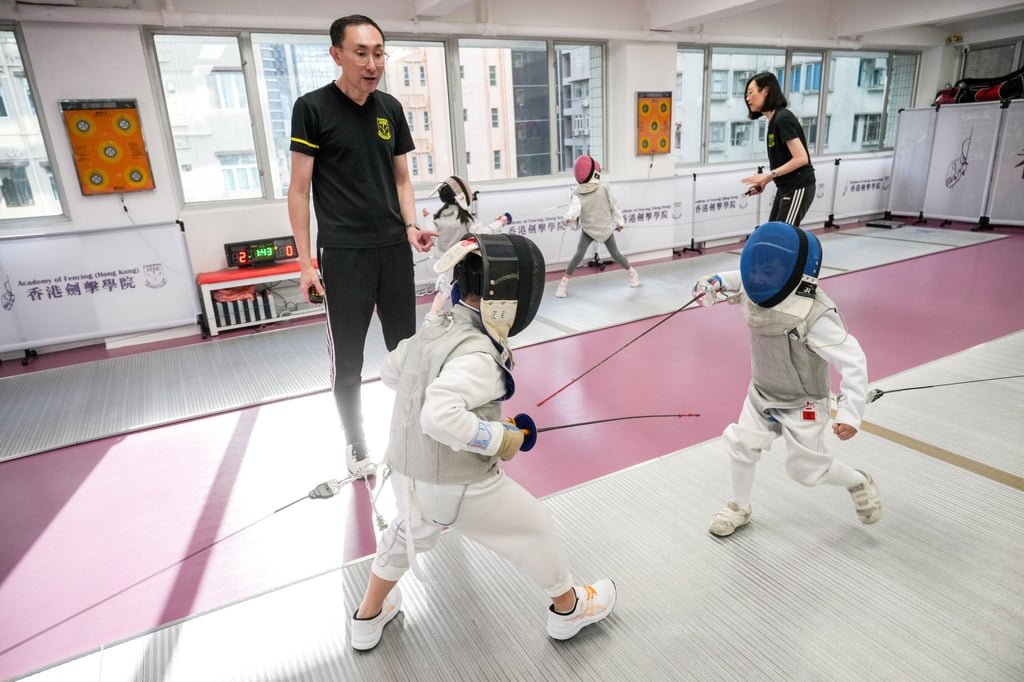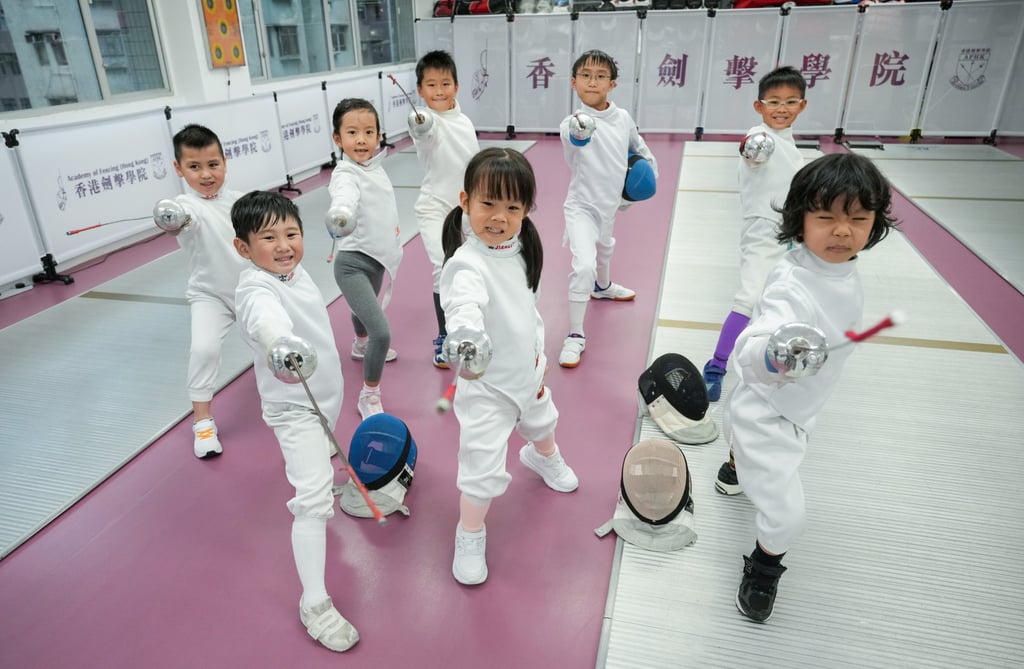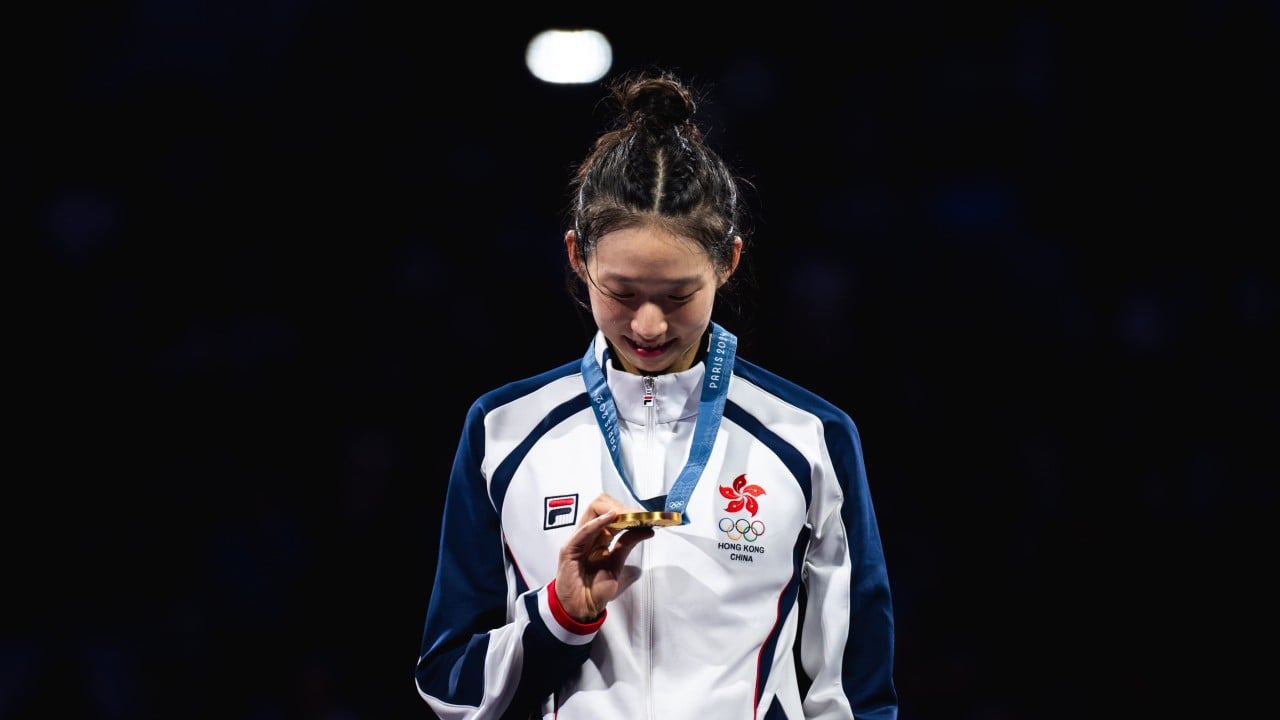The seeds of Hong Kong’s historic success in fencing at the Paris Olympics were sowed decades ago through strategic planning and substantial investment in nurturing talent, experts said.
Gold medallist and épéeist Vivian Kong Man-wai said on Sunday that she planned to “take a break” from being a professional fencer after nearly 20 years in the sport, but veteran athletes predicted more stars would emerge as the city entered its “harvest period” and hoped authorities could build more facilities to better engage the public.
Kong and foilist Cheung Ka-long brought home two gold medals from the Paris Olympics, sending the city into a fencing frenzy again after Cheung won his first gold in Tokyo three years ago.
Both attributed their success to their predecessors, upon returning to the city after taking part in the Games.
“Our senior fellows have achieved great results despite having fewer resources compared with what we have now, this has provided our generation with ample resources to pursue our dreams,” Kong said as she returned to Hong Kong on Thursday.
“I feel blessed to be a Hong Kong athlete, especially in fencing.”
Hong Kong Fencing Association chairman Yeung Wing-sun said systematic elite fencer training could be dated back to the 1980s, with the establishment of the Jubilee Sports Centre, now known as Hong Kong Sports Institute (HKSI).
Hong Kong fencers first won medals at the 1st Asian Youth Cadet Fencing Championships in 1989, with two gold and one silver.
“We built on the success of our predecessors … thanks to their efforts, the funding amount kept increasing in the past decades, which allowed us to slowly progress from regional competitions to international ones,” he told the Post.
The Culture, Sports and Tourism Bureau said funding support for Tier A elite fencers increased substantially in the past five years from HK$11.8 million (US$1.5 million) for 127 athletes in 2019-20 to HK$24.7 million for 133 athletes in 2024-25.
The sport has the highest number of elite athletes among all 20 Tier A sports, and the total funding allocated is the second highest, with cycling topping the chart.
The HKSI allocates its resources based on the achievements of athletes at major international competitions, with high-performance ones categorised as Tier A sports.
But Yeung hoped the government could soon realise the promise of building a fencing stadium for the city to host more local and international games.
“Our athletes took Hong Kong to the world stage, now it’s time to bring the world to Hong Kong too,” he said.
Lau Kwok-kin, a two-time fencing Olympian and co-founder of Fencing Master, said the increased support for athletes had enabled more to dedicate themselves to going full-time – an essential step in the pursuit of excellence.
In the past decade, the number of full-time athletes at the HKSI has more than doubled to about 500 in 2024, accounting for about 35 per cent of the 1,400 athletes.
“A full-time athlete two decades ago was only paid HK$4,000 a month, and I was admitted to the University of Hong Kong, so I went on to study instead,” he said.
“I still feel a bit of regret that I couldn’t devote myself to fencing, but I had to consider my future.”
Lau became a lecturer at a vocational training school and later opened a fencing school.
In recent years, the government stepped up support for athletes in terms of salary and retirement planning, he said.
Top athletes such as Cheung and Kong can be paid a monthly salary of more than HK$40,000.
Many universities have introduced top athletes’ direct admission schemes and awarded scholarships to them. They also received extra funding from the government for each athlete admitted.
Cheung was admitted to Baptist University to study a physical education and recreation management programme in 2022.
The authorities also set up initiatives to help retired athletes explore different career paths besides coaching, including administrative positions at sports organisations and sports promotion coordinators at schools.
Lau also said that the national team had offered many opportunities for emerging fencers to compete in championships, in teams and individually, with Nicholas Choi, Lee Yat-long and Lawrence Ng Lok-wang, among those who benefited.
“This is very important to the succession of talent at the Hong Kong team, especially after veteran fencer Cheung Siu-lun retired this year,” Lau noted.
Among the 133 elite fencers at HKSI, about 70 per cent are juniors.
But Lau added that many Hongkongers, despite being very supportive of the fencing team, struggled to understand the games.
“It would be very helpful for the overall fencing culture if local TV stations could broadcast fencing games more often,” Lau said.

Francis Lee Wing-keung, a former athlete and founder of the Academy of Fencing (Hong Kong), said the training quality of fencers also improved significantly with the hiring of world-class coaches, which happened after current head coach Zheng Zhaokang assumed the role in 2011.
They included former coaches of the French and Romanian national teams, Gregory Koenig and Octavian Zidaru, who started coaching Cheung and Kong in 2018 and 2015, respectively.
Lee said that both athletes had shown mental toughness in their performances, which could be attributed to coaching quality.
“Hong Kong is very resourceful in terms of fencing even when compared to other countries, for example, the pay of Hong Kong fencing coaches is among the highest in the world, and the HK$6 million medal bonus is also the highest,” he added
Coaches can earn as much as HK$1.3 million a year and a head coach can command a salary of more than HK$1.9 million, according to job advertisements on HKSI.
Lee added that the sport was able to solicit extensive support from the private sector as well, with many fencers and fencing events receiving abundant sponsorships.
He said that another turning point in the city’s fencing history came in the early 2000s when private fencing clubs formed by retired fencers emerged and recruited trainees as young as four years of age.
The number of clubs affiliated with the fencing association has doubled in the past decades to more than 40.
Based on the number of participants in major fencing competitions, he estimated that there were 20,000 active fencers in the city.
More parents are sending their children to fencing classes in hopes they can follow in the footsteps of Cheung and Kong, and because it was “good for their profile” when applying to elite schools, he said.
“Those fencing clubs serve as a base to train elite fences and allow people from all walks of life to participate in the sport, for example, as a spectator or sponsor.”
The price of a group class at private fencing clubs ranges from HK$200 to HK$500 or more, depending on the qualification of the coach. Cheaper classes are available at the Leisure and Cultural Services Department.
A full set of equipment costs between HK$2,000 and HK$3,000.

Lobo Louie Hung-tak, a senior lecturer in health and physical education at Education University, said the popularity of fencing among children and youths was one of the keys to its success.
“When the engagement is wide enough at the school and community level, there would be more talented fencers progressing to the pinnacle,” he said.
He added, beyond fencing clubs, physical education teachers at schools played a crucial role in promotion of the sport.
Louie said the Jubilee Sports Centre worked with the Education Bureau in the early days to help teachers become trainers.
“Hong Kong’s fencing team definitely has the ability to win more medals, it has many athletes that have achieved top rankings since a young age – they definitely have the potential,” he added.
Louie said that the city also has a culture of sending children to sports classes.
He added that Cheung had started with basketball and Kong with ballet.
But unlike most mainstream sports, “the requirements for [non-elite] fencing training is relatively more flexible,” he said.
“[Training] could happen at a simple playground or school hall … or in industrial buildings.”
Badminton and basketball players, however, often struggled to find a court for training, whether public sector or private.
Louie suggested the government should increase the number of fencing venues and highlighted the lack of a public venue to practice the sport.
Chief Executive John Lee Ka-chiu said last week that authorities would create a sports centre for fencing training and competitions as soon as possible.
He added the government would also review the performance of all of the city’s athletes at this year’s Games to see if any improvements could be made.


